Stuart Jeanne Bramhall's Blog: The Most Revolutionary Act , page 364
September 22, 2023
Aluminum in vaccines is the massive elephant in the room that very few want to talk about
Aluminum in vaccines is the massive elephant in the room that very few want to talk about because it's horrifying, and it's directly implicated in the huge spikes in chronic disease, neuro-developmental disorders, and autoimmune conditions we are seeing in epidemic proportions in… pic.twitter.com/Ky6vOIVTOp
— Inversionism (@Inversionism) September 22, 2023
How hot was your lot? Bad batches of Covid jabs in Japan
 Guy GinMaking (Covid) Waves in Japan
Guy GinMaking (Covid) Waves in JapanI didn’t intend to translate Prof Kojima’s articles three posts in a row, but since Ashmedai already wrote about the study by a Japanese cardiologist whose patients’ mortality rate doubled after getting the Covid jab, I guess I might as well do so.
Prof Kojima’s article is titled “Visible differences in adverse events between Pfizer vaccine lots”. As before, all quoted text is his; highlights are mine.
The documents submitted to the Adverse Reaction Investigation Committee of the Immunization and Vaccine Committee of the Health Science Council disclose the number of doses delivered, the number of serious adverse reactions reported, the number of deaths reported, and the frequency of death reports for each lot.
Figure 1 shows the frequency of death reports for each lot. The highest reported lot frequency was 0.0024%, with 9 lots having 0%. The median value was 0.0003%, with 13 lots having ≥0.001%.
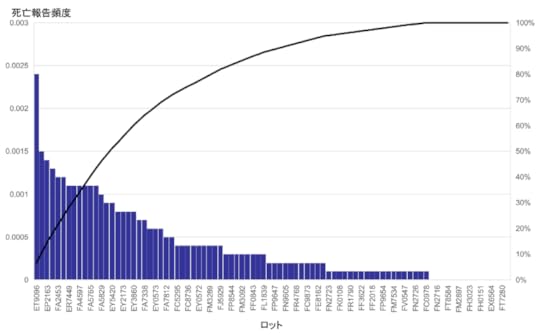 Figure 1 Frequency of death reports for each lot of Pfizer vaccine
Figure 1 Frequency of death reports for each lot of Pfizer vaccineFigure 2 shows the reported frequency of serious adverse events (AEs), which also show significant differences between lots. Serious is defined as 1) death, 2) serious injury, 3) things feared to lead to them, 4) hospitalisations, etc.
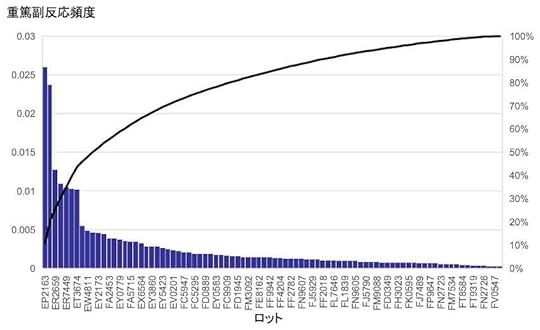 Figure 2 Frequency of serious adverse events reported for each lot of Pfizer vaccine
Figure 2 Frequency of serious adverse events reported for each lot of Pfizer vaccineFigure 3 shows the delivery timing of each lot. The death reporting frequency for all lots delivered after July 2021 was 0.0005% or less. On the other hand, among the 20 lots delivered during April and May 2021, 12 lots had a death report frequency of 0.001% or higher, and the frequency of death reports differed greatly depending on the delivery time.
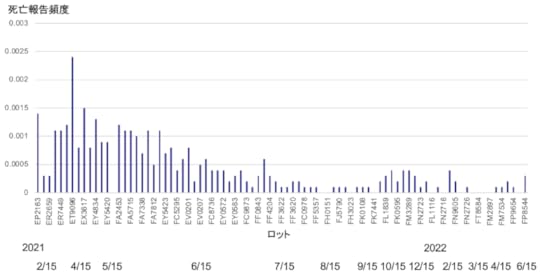 Fig. 3 Differences in the frequency of reported deaths depending on the delivery timing of Pfizer vaccines
Fig. 3 Differences in the frequency of reported deaths depending on the delivery timing of Pfizer vaccinesTable 1 shows the shipping date of each lot, the number of doses per lot, and the frequency of death reports. ET9096, which had the highest reported death rate of 0.0024%, contained a remarkably low number of doses, 462,150. The reason for the low number of delivered doses may be that this lot was realised to be dangerous and shipments were stopped.
 Table 1 Date of shipment of each lot of Pfizer vaccine, number of doses, and frequency of death reports
Table 1 Date of shipment of each lot of Pfizer vaccine, number of doses, and frequency of death reportsOne possible limitation of these data is that we don’t know the usage rates of these lots, so these results would be misleading if 100% of ET9096 was used but only 50% of EY2173, for example, was used. But that still doesn’t explain why AE frequency is 10-20 times higher for earlier lots than later ones.
To support his findings, Prof Kojima cites a study that found similar heterogeneity in Denmark, with lots comprising 4.22% of doses accounting for 70.78% of reported AEs, 27.49% of serious AEs, and 47.15% of reported deaths.
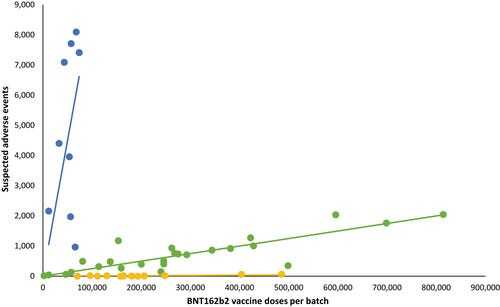 Vaccine batches representing the blue, green and yellow trendlines comprised 4.22%, 63.69% and 32.09% of all vaccine doses, respectively, with 70.78%, 27.49% and 47.15% (blue trendline), 28.84%, 71.50% and 51.99% (green trendline), and 0.38%, 1.01%, and 0.86% (yellow trendline) of all SAEs, serious SAEs, and SAE-related deaths, respectively
Vaccine batches representing the blue, green and yellow trendlines comprised 4.22%, 63.69% and 32.09% of all vaccine doses, respectively, with 70.78%, 27.49% and 47.15% (blue trendline), 28.84%, 71.50% and 51.99% (green trendline), and 0.38%, 1.01%, and 0.86% (yellow trendline) of all SAEs, serious SAEs, and SAE-related deaths, respectivelyIt’s probably worth noting that most AEs that actually get reported occur shortly after vaccination, so these data can’t tell us much about differences in longer-term AEs among lots. That said, the manufacturer and regulators claim these data can’t tell us anything at all.
Although Pfizer and the Ministry of Health, Labor and Welfare (MHLW) deny that there are lot-to-lot differences in the risk of death, looking at the data published by the MHLW, we have to admit that differences do exist.
Pfizer’s Covid vaccine is made by wrapping mRNA, which contains the blueprint for the spike protein, in a lipid nanoparticle (LNP), but the amount of mRNA contained in the LNP is known to vary. Since the spike protein produced depends on the mRNA content, the amount of spike protein produced in the body may also vary between lots.
AEs after Covid vaccination, including myocarditis and pericarditis, are thought to be due to the toxicity of the spike protein.
…
The reason the frequency of death reports decreased is likely to be a decrease in the mRNA content of lots delivered after July 2021.
Uniform quality assurance is one of the most important issues for pharmaceuticals.
The pharmaceutical application document for the Pfizer vaccine describes quality control methods and lists encapsulated RNA, RNA content, and lipid content as quality characteristics that affect the safety of the formulation, so Pfizer may have recorded the RNA content of each lot. The marked decrease in the frequency of death reports for lots delivered after July may be due to changes in the standards for the RNA content of shipped lots.
This is consistent with something Robert Malone recently wrote: “In the USA, the inoculations were unequally distributed and the formulations of the initial shot and the booster were not the same. So, it is difficult to compare adverse event frequencies and even the adverse events.” The highlighted part was news to me, but I guess he’s in a better position to know. The first round of boosters were given out in Israel and the US in summer 2021, so the timeline fits.
But even if Prof Kojima’s hypothesis is true, Pfizer and BioNTech aren’t going to admit they’ve fixed the early safety issues because that would mean admitting there were early safety issues that needed fixing.
This large difference in the frequency of death reports between lots may be related to the fact that the time from development to market for mRNA preparations was particularly short compared with other drugs. In Japan, this may be a case subject to the Product Liability Law.
I don’t know the law well enough to determine whether emergency usage authorisations cover hot lots, but the idea of suing the manufacturers for poor quality assurance isn’t completely theoretical. A man in the US who “suffered a stroke after receiving Remdesivir that was contaminated with glass particles” is suing Gilead Sciences. But even if it is possible, it won’t happen in Japan, where the the Covid jab makers have received far more protection than they’ve given in return.
[…]
Via https://guygin.substack.com/p/how-hot-was-your-lot-bad-batches
September 21, 2023
US Senate Again Rejects Call to Abolish COVID Vaccine Mandate for Teen Pages
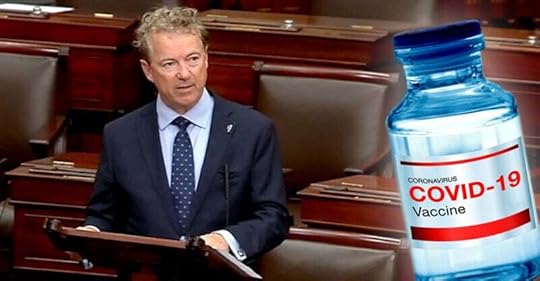
The Senate Pages program, which pays young adults ages 16 and 17 to assist on the senate floor, requires applicants be fully vaccinated against COVID-19 — including all boosters. Sen. Rand Paul (R-Ky.) cited studies on the risk of vaccine-induced myocarditis and the failure of the vaccines to prevent transmission in a speech on the senate floor.
Sen. Rand Paul (R-Ky.) on Tuesday for the third time introduced legislation to lift the COVID-19 vaccination requirement for young adults in the U.S. Senate Pages Program — and for the third time, the resolution failed.
The Senate Pages program, which pays young adults ages 16 and 17 to assist on the senate floor, requires applicants be fully vaccinated against COVID-19 — including all boosters.
Dr Paul last week introduced the same resolution but it failed to pass. His first attempt, which also did not pass, was a broader resolution introduced on Sept. 7 that sought to remove COVID-19 testing, vaccination and masking requirements for pages.
A press release issued Wednesday by Paul’s office said Senate Democrats “for the third time” refused to “follow the science” and “unanimously objected” to the resolution.
According to Paul, the requirement is politically motivated, not based on science, and puts healthy American young adults at risk for vaccine-induced myocarditis.
In a senate floor speech before the vote, Rand cited numerous studies that reported an increased risk of heart inflammation with each successive COVID-19 vaccination.
Paul said:
“Why are we forcing these kids to do something that I would say is against medical advice to be a page in our program here?”
“How would you feel if your perfectly-health football player or band member is given the vaccine and comes home with heart inflammation?”
Risk of vaccine-related myocarditis is greater than risk of hospitalization from COVID-19
Rand pointed out that a study by epidemiologist Dr. Tracy Beth Høeg, Ph.D., reported the risk of myocarditis in teenage boys after receiving a second dose of an mRNA COVID-19 vaccine was roughly 5 times greater than the risk of hospitalization from COVID-19.
“So you’re asking yourself, ‘Well, can my kid go to the hospital or get the heart inflammation?’” Paul said. Both are rare, he said, but there is a greater chance of heart inflammation.
Paul noted that among healthy children and young adults, there is a “nearly zero” risk of dying from COVID-19.
The public knows this and has “largely resisted” vaccinating their children against COVID-19, he added.
The argument that young people be vaccinated to protect more vulnerable populations does not hold up, Paul said, because “No serious scientist now argues that COVID-19 vaccines stop transmission. No one.”
He added, “Yet here we are, with Democrats saying, ‘You’re not smart enough to make your own decisions. We will make these medical choices for you.’”
‘In a free society, no one should be forced to receive an injection’
Paul called out Democrats for endorsing authoritarianism by expecting “submission” from U.S. parents. He said:
“They don’t want you to have the choice to keep your kids safe and make a decision whether or not your kid, who may well have already had COVID, needs yet another vaccine … They just want you to shut your eyes, be quiet and do as you’re told.”
Paul said the Democrats’ medical policy for citizens is to, “Shut up. Do as you’re told. Take the injection. We don’t care if your kid might get sick. We don’t care if you have a choice. We don’t care if you have any say in your kid’s medical care.”
“In a free society,” he added, “no one should be forced to receive an injection into their body that they do not wish to have.”
Watch here:
[…]
Via https://childrenshealthdefense.org/defender/senate-pages-covid-vaccine-mandate-rand-paul/
5 Questions for Gates Foundation About Its Failed Food & Farming Projects in Africa

By Stacy Malkan
U.S. Right to Know As the Bill & Melinda Gates Foundation’s annual Goalkeepers event convenes this week, pre-event press promises inspirational news for “thinkers and doers” who want to “save” dying mothers and nurture hope for a brighter world — but reporters should ask some key questions about the failure of the foundation’s “Green Revolution” in Africa.The Bill & Melinda Gates Foundation’s annual live-streamed Goalkeepers event convenes this week as world leaders gather for the 78th U.N. General Assembly.
Pre-event press promises inspirational news for “thinkers and doers” who want to “save” dying mothers and nurture hope for a brighter world.
If past Goalkeepers are a guide, this public relations event is likely to generate laudatory press coverage that ignores the global chorus of criticisms about the Gates Foundation’s agricultural development work in Africa.
Reporters who plan to cover Goalkeepers 2023 should inquire about these recent newsworthy developments.
Why is the Gates Foundation ignoring critiques from Africa-based groups?
In the wake of two important African food summits, a long list of food security and biodiversity experts; Africa-based farming, faith and seed sovereignty groups; and civil society groups around the world have documented the problems and failings of the Gates Foundation’s “green revolution” for Africa.
The Gates Foundation has largely ignored them all.
The Africa Climate Summit in Nairobi and the African Food Systems Summit in Tanzania (known as the African Green Revolution Forum before a recent rebranding) aimed to address the climate emergency and hunger crisis that has hit Africa hard.
The outcome? “False solutions and empty promises,” reports Million Belay of the Alliance for Food Sovereignty in Africa.
The two summits “suffered from the same flaws — doubling down on failed policies, excluding farmers and civil society, and endorsing the talking points flown in from rich-county boardrooms.”
You can hear from these groups directly in this and the recent wave of critical press coverage in Africa.
Where’s the data to justify continuing the green revolution approach?
The Gates Foundation’s own evaluations underpin these critiques.
As we reported last fall, the first major (publicly released) evaluation of AGRA suggests that the 15-year effort to expand capital-intensive, high-input agriculture has failed to achieve its goals of improving food security in Africa.
An earlier evaluation commissioned by the Gates Foundation in 2016 (and never publicly released; a summary is here) notes a lack of clarity, ambiguous identity, unrealistic goals, poor metrics and other shortcomings of the billion-dollar AGRA effort.
Independent assessments by Tufts Global Development and Environment Institute and African and German groups in 2020 provide further evidence, based on national-level data, that AGRA has not delivered significant yield or income gains for small farmers. The data shows that hunger grew by 30% across AGRA’s target countries during the AGRA years.
AGRA has disagreed with the Tufts research but has not provided data to rebut the findings.
Also worth noting: From the start, food policy experts predicted the green revolution for Africa would not solve hunger and poverty, and could make these problems even worse, because it ignored structural inequalities and the harsh lessons of the first green revolution in India.
How involved is the Gates Foundation in pushing laws that criminalize seed saving?
An exposé just out in The Nation by Alexander Zaitchik documents the effort by philanthropists and agribusiness companies to implement policies in Africa that criminalize seed saving.
According to The Nation:
“This past summer, the global trade regime finalized details for a revolution in African agriculture.
“Based on draft laws written more than three decades ago in Geneva by Western seed companies, the new generation of agricultural reforms seeks to institute legal and financial penalties throughout the African Union for farmers who fail to adopt foreign-engineered seeds protected by patents, including genetically modified versions of native seeds.
“The resulting seed economy would transform African farming into a bonanza for global agribusiness, promote export-oriented monocultures, and undermine resilience during a time of deepening climate disruption.”
The most direct beneficiaries of this plan, Zaitchik wrote, are:
“Four-company oligopoly that controls half the global seed market and 75 percent of the global agrichemicals market: Bayer (formerly Monsanto), Corteva (formerly DowDuPont), BASF, and Syngenta, a subsidiary of ChemChina.”
The article provides important historical context about the Gates Foundation’s role in the “new seed economy.”
Why is the Gates Foundation supporting writers who spread misinformation?
In a new peer-reviewed paper, molecular geneticist Michael Antoniou and colleagues analyzed a paper written by authors affiliated with the Gates Foundation-funded Alliance for Science, in which the authors try to equate critics of agricultural genetically engineered seeds and crops with people who make false claims about climate change, COVID-19 and vaccines.
The Antoniou study identified eight critical flaws in the paper — including inaccurate and potentially libelous accusations, misrepresentations of the science on genetically modified organisms (GMOs) and pesticides, an inaccurate definition of ‘misinformation’ and more falsehoods — showing that the Alliance for Science paper about misinformation is itself misinformation.
Multiple scientists, food policy experts and food groups have taken time over the years to analyze the writings of Lynas and the Alliance for Science, and they have documented many inaccuracies and misleading tactics the group and its lead writer have used in their efforts to promote GMOs and pesticides in Africa, with support from the Gates Foundation.
Where is the accountability?
The misinformation coming from a Gates-funded group is ironic because the Gates Foundation is trying to position itself as an arbiter of misinformation.
As I reported in 2020, the Gates Foundation donated $10 million to the Alliance for Science specifically “to counter conspiracy theories and disinformation campaigns that hinder progress in climate change, synthetic biology, agricultural innovations.” That they are doing so with documented misinformation is newsworthy.
The Gates Foundation has sidestepped accountability, avoided a reckoning with race and power, given to the rich while claiming to help the poor and evaded serious scrutiny for a long time, as Timothy Schwab has documented in a series of articles in The Nation (and a new book out soon).
[…]
Via https://childrenshealthdefense.org/defender/gates-foundation-food-farming-africa-rtk/
Maine Medical Board Puts Dr. Meryl Nass on Probation, Imposes ‘Draconian’ Sanctions
 By Suzanne Burdick, Ph.D.
By Suzanne Burdick, Ph.D. In a unanimous vote, the Maine Board of Licensure in Medicine on Tuesday found Dr. Meryl Nass guilty of multiple allegations of professional incompetence and placed Nass on probation for two years with a provisional license.
The board also issued a set of remedial sanctions that Nass must complete before being allowed to freely practice medicine again.
During its seventh day of hearings, the board determined Nass had violated medical recordkeeping standards for telemedicine and failed to provide informed consent to three COVID-19 patients for whom she had prescribed hydroxychloroquine and ivermectin.
Nass, a practicing internal medicine physician and member of the Children’s Health Defense (CHD) scientific advisory board, faced the initial suspension of her license on Jan. 12, 2022, for spreading COVID-19 “misinformation.”
The board later dropped the charges of misinformation but came up with a new set of charges. The board based their Sept. 19 decision on this new set of charges.
Rather than conducting the hearings over consecutive days, the board held hearings about every other month since October 2022 — with Nass’s ability to practice medicine being suspended the entire time.
The board’s decision on Tuesday runs contrary to the testimonies of Nass’ patients who, according to Nass’ attorney, all made “glowing comments” about her availability, her medical advice and her handling of their cases.
Nass discussed the board’s decision with CHD President Mary Holland on Wednesday’s episode of Good Morning, CHD, telling Holland the board chose “the most draconian punishments they possibly could” in order to humiliate her.
For example, the board is requiring Nass to take courses in professional ethics and medical recordkeeping and mandating she hire someone to monitor her practice “who would review my charts and possibly sit next to me in the office.”
The board’s decision order, which contains the exact details of the probationary period and remedial sanctions, has yet to be made public, Nass told The Defender.
Nass targeted as ‘prominent’ doctor opposing COVID shots
According to Holland, Nass — an outspoken critic of the COVID-19 vaccines — was likely targeted by the board because she is “a prominent physician who was courageous enough to not go along with the official narrative that you have to take these shots.”
Nass has a Substack blog and is a prominent voice in the medical community with an impeccable record, Holland said.
“Clearly, you are targeted probably not just by the Maine medical board, but even by the Federation of State Medical Boards that’s been so powerful in California and in state policies throughout the country,” Holland told Nass.
Holland told viewers CHD is assisting Nass with legal fees. “I am very delighted that we are working with you on this,” she said.
Nass pointed out that the board’s decision ignored extensive evidence presented during the prior six hearing sessions. She said:
“What had been established during these six prior hearing days was that my records were adequate, that the patients had all been treated properly, that I had not delayed recommending two of them go to the hospital.
“In fact, I had done it very appropriately and their own expert acknowledged that.”
Assistant attorneys general representing the board staff on Sept. 15 submitted closing arguments to the board in which they “completely ignored all the evidence.”
According to Nass, the board members relied heavily on those arguments as the basis for their decision and ignored the 30 pages of closing arguments that Nass’ attorneys submitted the same day, summarizing why Nass was not guilty of the remaining charges against her.
“We had nine people’s testimonies, we had hundreds — maybe a thousand documents — admitted as evidence, and none of that counted,” Nass said.
Nass also said the board intentionally avoided permanently revoking her license because then she could have immediately gone in front of a judge and the judge would then have access to the entire record for the hearings.
In that scenario, “The judge would read it and immediately be aware that what they [the board members] had done on day seven had nothing to do with the previous six days and then they would be in trouble,” she explained.
“That was something they did not want to have happen … so that’s why the punishments were meted out in the way they were,” Nass said.
Board hearings designed to show Nass ‘who was the boss’
Nass told Holland the hearing was “an expensive process designed to humiliate me, waste my time and money and show me who was the boss.”
She added:
“I don’t get to say what I think. I don’t get to write what I think. I don’t get to treat patients the way I think and the patients certainly cannot get the care they want. The board is the final arbiter.”
Holland said the hearing sounded like a “show trial” that is “really about showing a power dynamic” rather than about seeking justice or finding out what happened.
Holland said it seemed Nass was targeted “to send a message to doctors everywhere that, ‘You don’t get to do what you think is in the patient’s best interest. You do what we tell you to do.’”
Holland also said she found it “extraordinary” that the board members “conveniently forgot” the basis on which they brought charges against Nass and then put up new charges “obviously to humiliate you.”
‘The board really is the one breaking the law’
Last month, Nass sued the board and its individual members, alleging they engaged in retaliatory conduct when they suspended her license in January 2022.
The suit also alleges the board violated her First Amendment rights and her rights under the Maine Constitution.
“The board really is the one breaking the law and so we are suing them,” she told Holland.
For instance, the main expert witness the board hired to use against Nass — Dr. Jeremy Faust, an emergency room physician from Brigham & Women’s Hospital in Boston — was hired illegally, she said.
“He was paid about three times the maximum amount allowed by law in the state of Maine. He was not licensed in Maine, which is a requirement, and he was not in my field,” she said.
Nass told Holland she was willing to continue her battle with the board “and to potentially lose my license forever” because the heart of her case is about defending the patient-provider relationship.
Nass said:
“[This battle is] about whether doctors and patients will be allowed in the future to decide on the care of the patient or whether there will be intrusions by the federal government, the insurance companies, the WHO [World Health Organization], the U.N. [United Nations], etc. who will be calling the shots and telling us what we can and can’t do to treat patients.”
Such intrusions into the patient-provider relationship could signal an end to the medical profession as we know it, Nass said. “If doctors don’t have the ability to treat patients individually, there’s no need to have doctors. A computer can do this just as well.”
She added, “You tell them what your symptoms are, they give you a diagnosis and they give you this treatment, the same treatment that everybody else gets, which was the plan for COVID-19.”
[…]
The MMR vaccine and threats to quarantine perfectly healthy children

Health Advisory and Recovery Team
A coercive scare story to increase vaccine uptake?
On 14th September BBC News reported London measles warning ‘Outbreak could hit tens of thousands’
Reading on, you discover this is based on our favourite dislocation from the real world: computer modelling.
‘ Mathematical calculations suggest an outbreak could affect between 40,000 and 160,000 people… This is a theoretical risk, rather than saying we are already at the start of a huge measles outbreak. There have been 128 cases so far this year, compared with 54 in the whole of 2022. ’
Theoretical is one word for their calculations, scare-mongering is another. Reports for the last 20 years vary widely with the highest being over 6000 cases in 2013 (see figure 2 below).
‘The UKHSA also says a large outbreak could put pressure on the NHS, with between 20% and 40% of infected people needing hospital care.’
Ring any PROTECT THE NHS bells?
But worse was to follow. On 15th September, it was reported:
‘ Councils in London have written to households to say the capital could be facing a major outbreak unless MMR inoculation rates improve…Measles is highly contagious and severe cases can lead to disability and death…Any child identified as a close contact of a measles case without satisfactory vaccination status may be asked to self-isolate for up to 21 days.’
This threat of sending children home for a disease they don’t have, will resonate with parents whose children were repeatedly sent home for 10 days at a time, for one child with a positive covid test. As also will the inducement of:
‘Parents have been urged to check children’s health records to ensure that their vaccines are up to date.’
A ‘nudge’ technique not a million miles from the threat of vaccine passports for nightclubs, used to increase covid vaccine uptake in 18-25-year-olds but never actually implemented.
MMR vaccine uptake levels have been variable ever since its inception. Herd immunity levels of 95% are quoted as the level required to stop measles completely. But measles has never been a condition listed for total eradication. Cases fluctuate with mini outbreaks every 5-6 years and this was always the case before the availability of the measles and later the MMR vaccine. So how real is the current threat and how could it possibly justify such a discriminatory measure as excluding unvaccinated children from school?
From the headlines, parents may think that measles has a high death rate and whilst that was certainly true in the past and remains true in developing countries, improved nutrition and widespread access to health care in the UK was associated with a huge decline in measles deaths. The death rate declined from over 1,100 per million in the mid nineteenth century to a level of virtually zero by the mid-1960s.
Ninety-nine percent of the reduction in measles deaths in England & Wales occurred before the introduction of the measles vaccine in 1968 and deaths have continued to fall since then.
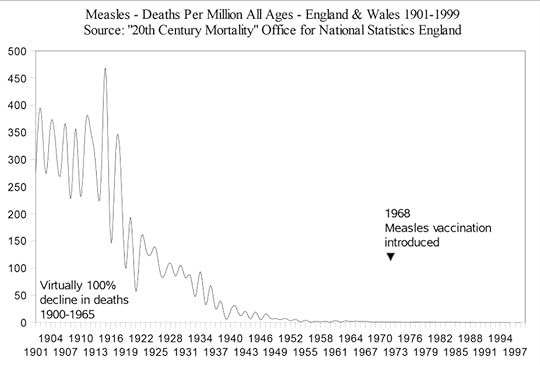
Figure 1 Twentieth Century Mortality CDROM Office for National Statistics. Measles mortality
More recent figures show case reports fluctuating widely and deaths of children from measles varying between 0 and 2 per annum. For example, in 2013 when there were over 6000 reported cases, there was 1 adult and 0 child deaths.
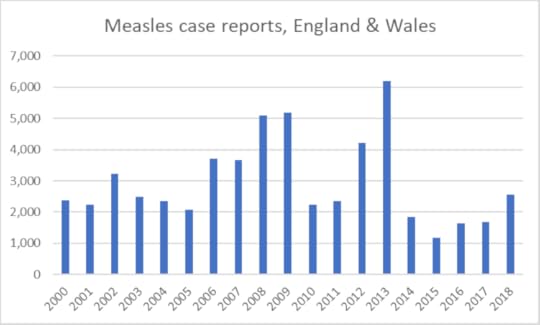
Figure 2. Measles notifications in England & Wales 2000 to 2018 – data from UKHSA
As for the quoted likely 20-40% admission rate, this is certainly nothing like the 3% admissions quoted in the pre-vaccination era. Is this just another part of the scaremongering?
That is not to say that deaths cannot occur or serious complications such as pneumonia or hearing loss. But for the vast majority of children, measles is what it was always described as, namely a ‘childhood illness’. It is noteworthy that WHO recommends
‘ All children or adults with measles should receive two doses of vitamin A supplements, given 24 hours apart. This restores low vitamin A levels that occur even in well-nourished children. It can help prevent eye damage and blindness. Vitamin A supplements may also reduce the number of measles deaths.’
In a systematic review published in 2002, two doses of water based vitamin A were associated with a 81% reduction in risk of mortality (RR=0.19; 95% CI 0.02 to 0.85). Nowhere is this simple measure mentioned in UK guidance.
The parents who have chosen not to get their children vaccinated will accept the possibility of them catching measles, but sending them home for 3 weeks isn’t going to make this go away. A policy which writes in educational discrimination against unvaccinated children is hardly going to improve trust in public bodies. Moreover, the GMC Guidance on Decision making and Consent states in paragraph 48:
‘If you disagree with a patient’s choice of option: You must respect your patient’s right to decide. … you must not assume a patient lacks capacity simply because they make a decision that you consider unwise’
[…]
31 Countries to Participate in the Russian Currency Market

 Newsletter
Newsletter
Among them are Brazil, India, China, South Africa, Türkiye, Iran, Qatar, United Arab Emirates, Cuba and Venezuela.
On Thursday, Prime Minister Mikhail Mishustin signed a provision so that banks and brokers from 31 countries can participate in the Russian foreign exchange and financial derivatives markets.
The list includes seven countries of the former Soviet Union: Azerbaijan, Armenia, Belarus, Kyrgyzstan, Tajikistan, Turkmenistan, and Uzbekistan. It also includes Brazil, India, China, and South Africa, all of which are part of the BRICS group.
The Russian government provision also covers countries such as Serbia, Türkiye, Iran, Qatar, Pakistan, United Arab Emirates, Morocco, Malaysia, Cuba and Venezuela.
The decision is part of the rules adopted in July, which seek to increase the efficiency of the mechanism for direct conversion of currencies of friendly and neutral countries, as well as to enhance the formation of direct quotes of the ruble to satisfy the demand for settlements in national currency.
85% of central banks around the world want to buy more Yuan for their foreign exchange reserves.
De-dollarization has become more urgent since the US stole $300 billion of Russian FOREX.#China #renminbi #dollar pic.twitter.com/elIgzb4qZh
— S.L. Kanthan (@Kanthan2030) January 16, 2023
On Wednesday, Venezuela and Russia reaffirmed their strategic friendly relations with a view to building “a new world order.” This happened during a meeting held between Foreign Ministers Yvan Gil and Sergei Lavrov, which took place within the framework of their participation in the United Nations General Assembly (UNGA).
Lavrov celebrated Venezuela’s proactive role in regional affairs, its contribution to intensifying integration processes, and its promotion of rapprochement between Latin America and the Eurasian Economic Union (EEU).
The Bolivarian Foreign Minister also met with the Foreign Minister of Qatar Sheikh Mohammed bin Abdul Rahman Al Thani, with whom he also strengthened cooperation ties.
[…]
1215: A Sanitized Version of the Crusades
 Episode 10 The Crusading Impulse*
Episode 10 The Crusading Impulse*
1215: Years That Changed History
Dr Dorsey Armstrong (2019)
Film Review
In this lecture, Armstrong covers the Reconquista, the first three crusades and the Knights Templar, the Knights Hospitalier and the Teutonic Knights
The Reconquista, an organized effort (between 772 and 1492) to reconquer Spain from its Muslim occupiers, was an early precursor to seven crusades between 1095 and 1221 to 1) liberate Christians in the Byzantine Empire living under Turkish occupation and 2) to free Jerusalem from Muslim control. Central Asian Turks (many of who were Muslim) had conquered the periphery of Byzantium in the early 11th century. Armstrong covers the first three crusades in this lecture.
First Crusade
Prior to the First Crusade called by Pope Urban II, there was a sizeable Christian population in Jerusalem, which had lived in harmony with Jewish and Muslim neighbors for centuries. Following Pope Urban’s call for Christian men of fighting age to “take the cross,” approximately 50,000 Europeans set off on the first Crusade in 1098. Conquering Jerusalem in 1099, the6 established four states: the counties of Trepoly and Edessa, the principality of Antioch and the kingdom of Jerusalem. Although most crusaders returned to Europe following their victory, a few remained in the Middle East to rule their new territories.
The Knights Templar
The conquest of Jerusalem led to a surge in trade between the Middle East and Europe, as well as a host of Europeans embarking on pilgrimage to Jerusalem. To protect them against robbers, Hug of Payns founded the Knights Templar (monks with permission to engage in physical violence) to protect them against highwaymen. The Knights Templar also allowed them to deposit funds in Europe they could redeem on arrival in Jerusalem. By the early 13th century, there were 200,000 Knights Templar managing the massive banking empire they had created.
A conflict with the king Philip IV of France in the 14th century led to their dissolution and confiscation of their wealth.
Knights Hospitalier
The Knights Hospitalier, also formed in the 13th century, provided hospital care for pilgrims who became ill in Jerusalem.
Teutonic Knights
A smaller group formed later in the 12th century, the Teutonic Knights helped injured crusaders. Relocating from the Middle East to Eastern Europe (where Christians were fighting non-Christian Slavs) They eventually conquered Prussia in the late 13th century.
Second Crusade
In 1144 the Saracen leader Zengi retook Edessa, leading to the Second Crusade led by the by strong Knights Templar supporter the Cistercian Abbott Bernard of Clairveau, Louis VII of France and Conrad III of Germany. After failing to scale the wall of Damascus (which was considerably south of Edessa), they retreated and headed home again.
Third Crusade
Called in in 1189, the Third Crusade was called to liberate the Holy Lands after Saracen leader Saladin recaptured Jerusalem and all but a few port cities in 1187. Led by King Philip Augustus of France, Frederick Barborosa (the Holy Roman Emperor) and King Richard the Lion-Hearted of England, it was largely a failure, except for a small group of crusaders who occupied conquered Cyprus.
*Armstrong is quite vague in explaining the uncanny ability of Pope Urban II (and of subsequent popes) to mobilize tens of thousands of men to leave their homes to risk their lives battling unknown foreign peoples. The only explanation she offers here is the law of primogeniture (under which nobles bequeathed all their land to their firstborn son), leaving subsequent sons with no income or occupation other than the church or military. Other historians have begun to look at the role of Venetian bankers (who in the 13th century controlled all finance and shipping, as well as several colonies in modern day Romania), who profited handsomely from all the crusades, especially the fourth. See Venice and the Crusades
Film can be viewed free with a library card on Kanopy.
https://www.kanopy.com/en/pukeariki/watch/video/12392969/12392990
September 20, 2023
Biden administration tried to censor this Stanford doctor, but he won in court
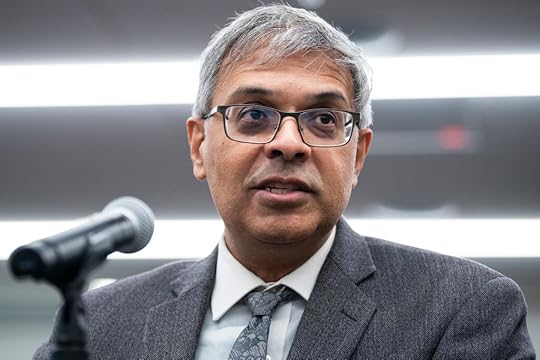
Getty Images
Rikki SchlottNew York Post
A federal court of appeals ruled earlier this month that the White House, surgeon general, CDC and FBI “likely violated the First Amendment” by exerting a pressure campaign on social media companies to censor COVID-19 skeptics — including Stanford epidemiologist Dr. Jay Bhattacharya.
“I think this ruling is akin to the second Enlightenment,” Bhattacharya told The Post. “It’s a ruling that says there’s a democracy of ideas. The issue is not whether the ideas are wrong or right. The question is who gets to control what ideas are expressed in the public square?”
The court ordered that the Biden administration and other federal agencies “shall take no actions, formal or informal, directly or indirectly” to coerce social media companies “to remove, delete, suppress or reduce” free speech.
Bhattacharya, a professor of medicine, economics and health research policy at Stanford University, co-authored the Great Barrington Declaration in the fall of 2020 with professors from Harvard and Oxford.
The epidemiologists advocated for “focused protection” — safeguarding the most vulnerable Americans while cautiously allowing others to function as normally as possible — rather than broad pandemic lockdowns.
The Fifth Circuit court found that the Biden administration and other federal agencies pressured social media companies to censor dissenting views on COVID-19.
“We were just acting as scientists, but almost immediately we were censored,” said Bhattacharya, director of Stanford’s Center for Demography and Economics of Health and Aging. “Google de-boosted us. Our Facebook page was removed. It was just a crazy time.
“The kinds of things that the federal government was telling social media companies to censor included us — along with millions of other posts from countless other people who were criticizing government COVID policy,” he added.
A New Orleans-based three-judge panel found that the federal government “likely coerced or significantly encouraged social-media platforms to moderate content” by vaguely threatening adverse regulatory consequences if social media companies did not suppress certain viewpoints on the pandemic.
“The government had a vast censorship enterprise,” Bhattacharya said. “It was systematically used to threaten and coerce and jawbone and tell all these social media companies, ‘You better listen to us: Censor these people, censor these ideas, or else.’”
It was later revealed that then-NIH director Dr. Francis Collins called for a “swift and devastating takedown” of Bhattacharya and his co-authors — whom Collins dubbed “fringe epidemiologists” — in an email to Dr. Anthony Fauci.
Subsequent reporting from Elon Musk’s so-called Twitter Files — internal documents and communications released by Musk, after he bought the platform, to expose Twitter’s inner workings — revealed that Bhattachrya’s profile was being suppressed on the platform.
“It’s akin to the efforts by governments to suppress the printing press when it first was invented, when books represented an enormous threat to power,” Bhattacharya said, referring to efforts by King Henry VIII and the Catholic Church to curb use of the printing press in the 16th century.
“There’s an analogous fight that’s currently going on with social media, which makes it vastly easier for anybody to express their ideas, and very powerful people find that incredibly threatening.”
The September 8 ruling affirmed but narrowed a lower court order, issued on July 4 by US District Judge Terry Doughty, which found that the Biden administration and other federal agencies “engaged in a years-long pressure campaign [on social media outlets] designed to ensure that the censorship aligned with the government’s preferred viewpoints” and that “the platforms, in capitulation to state-sponsored pressure, changed their moderation policies.”
Bhattacharya says the first victory, although in a lower court, was the most exciting to him.
“I was just absolutely thrilled, especially to have it on July 4th,” he said. “I think that judge was sending a message by issuing this ruling on July 4th that we’re going to restore free speech in this country.”
The Biden administration appealed to the Supreme Court on Thursday — a move that Bhattacharya anticipated.
But he believes it’s “unlikely” the Supreme Court will overturn the Fifth Circuit’s decision.
He feels his is a landmark case in curbing the influence the government has over social media — on matters that extend far beyond just COVID-19 and lockdowns.
“This new technology has created enormous opportunities for people to participate in debate in the public square,” Bhattacharya said. “And I hope that this is the beginning of a legal infrastructure that enables that to happen — rather than the opposite, which is a dark age where the government gets to decide what’s true and what’s allowed to be said.”
[…]
Via https://nypost.com/2023/09/20/how-dr-jay-bhattacharya-beat-biden-administration-censorship/
White House at Loss to Deal with Growing Anti-Vaccine Movement
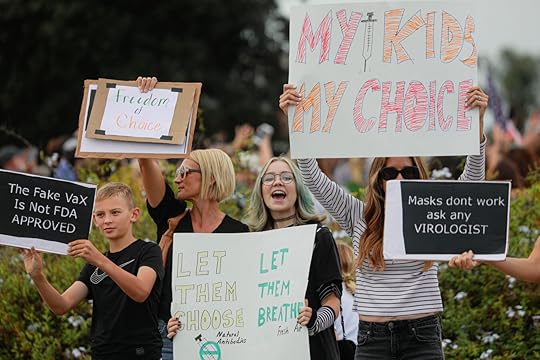
By Adam Cancryn
Politico
A Biden administration that vowed to restore Americans’ faith in public health has grown increasingly paralyzed over how to combat the resurgence in vaccine skepticism.
And internally, aides and advisers concede there is no comprehensive plan for countering a movement that’s steadily expanded its influence on the president’s watch.
The rising appeal of anti-vaccine activism has been underscored by Robert F. Kennedy Jr.’s insurgent presidential campaign and fueled by prominent factions of the GOP. The mainstreaming of a once-fringe movement has horrified federal health officials, who blame it for seeding dangerous conspiracy theories and bolstering a Covid-era backlash to the nation’s broader public health practices.
But as President Joe Biden ramps up a reelection campaign centered on his vision for a post-pandemic America, there’s little interest among his aides in courting a high-profile vaccine fight — and even less certainty of how to win.
“There’s a real challenge here,” said one senior official who’s worked on the Covid response and was granted anonymity to speak candidly. “But they keep just hoping it’ll go away.”The White House’s reticence is compounded by legal and practical concerns that have cut off key avenues for repelling the anti-vaccine movement, according to interviews with eight current and former administration officials and others close to the process.
[…]Biden officials have felt handcuffed for the past two years by a Republican lawsuit over the administration’s initial attempt to clamp down on anti-vaxxers, who alleged the White House violated the First Amendment in encouraging social media companies to crack down on anti-vaccine posts. That suit, they believe, has limited their ability to police disinformation online. In addition, Congress is clawing back Covid funds once earmarked for vaccine education and outreach. And Biden himself has opted to largely ignore Kennedy’s campaign, concluding there’s no political benefit to engaging with the increasingly longshot challenger or his conspiratorial views.
The approach has given conservative influencers and lawmakers who have embraced Kennedy and other vaccine skeptics more space to promote their views and tout themselves as free speech warriors doing battle against the Biden administration.
And the impact is clear: As another Covid vaccination campaign gets underway, fewer Americans than ever have kept up to date on their shots. Child vaccination rates against the flu are measurably lower than before the pandemic. Even standard childhood inoculations to prevent diseases like the measles are subject to deepening partisan divisions, with recent polling showing Republicans are now more than twice as likely to believe the shots should be optional than they did in 2019. Democrats, by contrast, remain overwhelmingly in favor of childhood vaccine requirements.
[…]
Yet as Biden’s attention shifts to the 2024 race, administration officials and others close to the process say there is waning focus on the politically divisive public health issues that consumed his first two years.
The White House dissolved its Covid response team earlier this spring in favor of a new office focused on broader pandemic threats and is no longer deeply involved in combating the vaccine conspiracy theories flourishing daily online. When top officials mention the pandemic, it’s now mainly to tout the nation’s emergence from its crisis phase. As for Biden, he openly defied his administration’s Covid guidance earlier this month, declining to wear a mask in public on multiple occasions after being exposed to the virus.
Biden aides have instead delegated much of the responsibility for ongoing public health work back to HHS. But combating anti-vaccine sentiment on a large scale is not considered a top priority within the department, where Health Secretary Xavier Becerra has at times indicated he believes the administration has done all it can do.
“If you’re dying of Covid today, you didn’t take precautions,” Becerra said during a POLITICO health summit in June, taking an oblique shot at Florida Gov. Ron DeSantis and other prominent Republicans who have advanced anti-vaccine theories. “If you listened to someone who said you didn’t have to take that precaution, it’s not just your fault, it’s the fault of that leader who doesn’t give you the best information. If leaders choose not to take care of their people, that’s on them.”
The CDC, under new director Mandy Cohen, has sought to be more vocal in countering disinformation of late. After DeSantis’ state surgeon general advised healthy residents not to get the most recent booster, Cohen called the decision “unfounded and, frankly, dangerous.”
Yet the Biden health department no longer has the resources to run the sprawling network of community-level initiatives that proved effective in boosting trust in the vaccines early in the Covid response, as congressional support for Covid funding has dried up. Those still trying to make headway lamented the inability to keep up with fast-moving conspiracies spreading across social media, leaving them overwhelmed by the flood of myths and misconceptions that gain traction before the government can mount a response.
“This is asymmetrical warfare by definition,” said one former health official who worked on the administration’s public health messaging. “We will need the people who have the levers to change that equation to focus on this issue. Being right is wildly insufficient to win a public debate.”
The administration’s scaled-back approach to the anti-vaccine movement represents a notable shift from early in Biden’s presidency, when the success of his agenda hinged on vaccinating the nation against Covid.
[…]The 2022 lawsuit led by Republican attorneys general that targeted the administration’s work with social media companies dealt a major blow, quashing the prospect of a sustained effort to push back on anti-vaccine campaigns or target influential figures responsible for spreading conspiracy theories.
The suit set back the administration for months, according to three people familiar with the matter, as White House lawyers discouraged any initiatives that might add to the allegations.
Despite trying to not provoke a judicial rebuke, a federal judge in Louisiana nevertheless sided with the GOP plaintiffs in a July ruling. The judge banned a range of Biden officials and agencies from talking with social media companies, though the prohibition has since been paused while the administration seeks an intervention by the Supreme Court.
[…]The administration also found itself mired for months in a standoff with congressional Republicans over more Covid funding. During that time, it pared back its ambitions and messaging, maintaining during the most recent vaccination campaign last fall that its role was primarily to ensure the vaccine was available for those who wanted it. Just 20 percent of adults got last year’s shot, according to CDC data through May 11, down sharply from the 79 percent of adults who received their initial series of vaccinations in 2021.
The White House has since dropped its push for more Covid money in the face of solidified Republican opposition, instead agreeing earlier this year to let Congress claw back more than $27 billion of unspent funds in exchange for salvaging $5 billion earmarked for next-generation vaccines.
[…]
Via https://childrenshealthdefense.org/defender/covid-nw-fauci-making-millions-pandemic-backlash/
The Most Revolutionary Act
- Stuart Jeanne Bramhall's profile
- 11 followers



